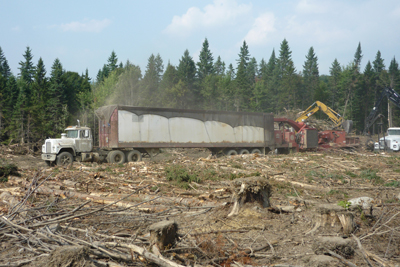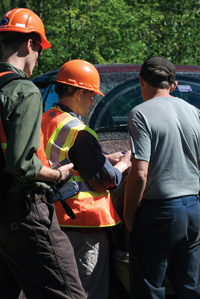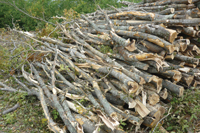
Take It or Leave It?
December 1, 2010
By Dr. Jeffrey Benjamin
Woody biomass retention guidelines were developed recently for Maine’s forest industry to proactively address some concerns associated with woody biomass harvesting.
Woody biomass retention guidelines were developed recently for Maine’s forest industry to proactively address some concerns associated with woody biomass harvesting. It is important to note, however, that woody biomass harvesting in Maine is not a new concept. In fact, bioenergy facilities that produce electricity by burning wood are common throughout the state, and many have been in operation since the 1980s. Some are stand-alone facilities and others are integrated within pulp and paper mills. Previously, Maine did not have guidelines specific to woody biomass harvesting, so why are they needed now? What do they address? How will they be implemented? And can lessons learned in Maine be applied to other regions?
 |
|
| Both roundwood products and biomass chips are being produced from an integrated whole-tree operation. Photo: Jeff Benjamin
|
Need for Guidelines
There has been a significant increase in wood-for-energy initiatives throughout Maine over the last few years. In fact, biomass chip harvests have increased more than threefold since 2000, according to the Maine Forest Service’s 2009 annual publication (www.maine.gov/doc/mfs/pubs/annpubs.htm). That trend is expected to continue, given plans for new and expanded capacity in the region for wood pellets, bioenergy, and bioproducts. We still do not know the impact these new initiatives will have on wood supply, but it is certainly possible that competition for raw material among wood-using facilities will increase. Increased competition may affect harvest levels through shorter rotations or increased use of small-diameter and poor-quality stems. This may also create opportunities for timber stand improvement by combining such harvests with conventional forest management and silvicultural treatments. Regardless of the outcome, there is concern that these and other related activities will put more pressure on forests1,2.
The Details
In 2007, an initiative led by the University of Maine, in collaboration with the Maine Forest Service and the Trust to Conserve Northeast Forestlands, was undertaken to proactively address some environmental concerns related to biomass harvests within Maine’s forest industry. The initiative was funded by the Natural Resources Conservation Service, the Maine Forest Service, the Maine Outdoor Heritage Fund, and the University of Maine’s Forest Bioproducts Research Initiative. The goal was to develop a set of site-level, voluntary guidelines to assist loggers, landowners, and foresters in protecting soils, water quality, and forest biodiversity with respect to leaving woody biomass behind during forest operations, i.e., woody biomass retention. The guidelines focus on woody biomass as a product, with woody biomass defined as logging residues, poor-quality stems, and other such woody material harvested directly from the forest, typically for the purpose of energy production. Energy wood is probably the best term to describe this material3, but biomass is simply too ingrained in the lexicon of forest practitioners in Maine!
The initiative involved a multi-stakeholder consultation process representing views of foresters, landowners, wood-using facilities, loggers, and conservation groups. A review of scientific studies relevant to environmental impacts associated with biomass harvesting formed the basis of a technical report from which specific guidelines for woody biomass retention were developed. Both the technical report4 and a brochure-style summary can be found on the publications link at www.forest.umaine.edu/faculty-staff/directory/jeffrey-benjamin/ . The documents were reviewed externally by respected professionals from the fields of soil science, water quality, and biodiversity. The final guidelines represent the collective effort of many individuals with diverse perspectives on Maine’s forest industry. As a result, not everyone is in agreement with all aspects of the recommendations, but the work was undoubtedly improved by using the consultative approach.

|
|
| Jeff Benjamin (centre) discusses woody biomass retention guidelines with local loggers, who will be instrumental in the guidelines’ proper implementation. Photo: University of Maine Forest Bioproducts Research Initiative |
There is ample scientific evidence to support the importance of soil productivity, water quality, downed wood, and wildlife trees, but we still lack hard evidence for selecting specific, site-level targets. For example, Maine’s biodiversity guidelines5 describe stand-level targets for forest structure, but these and other regional targets are qualified by statements indicating it is not always possible or appropriate to manage the habitat requirements for all species in all areas at the same time and that some management practices can conflict with each other. With respect to soil productivity, there are numerous processes involved in determining nutrient availability at a given site. Many of these, including atmospheric deposition, parent material, and rate of mineral weathering, have very little to do with the amount of woody biomass retained on a site. For those reasons, Maine’s biomass retention guidelines follow a more educational approach to highlight the importance of specific site-level characteristics, rather than a prescriptive approach of setting specific targets. This approach may work well in other regions too.
Next Steps
All acres of forest cannot be managed the same way, and the guidelines should not be interpreted in that manner. The guidelines address elements of forest structure, including snags, wood of all sizes left on the forest floor, live cavity trees, and mast-producing trees. Although the guidelines are applicable to any harvest operation, they may be of greatest importance for harvests in which woody biomass is a significant component of the product mix. Fundamentally, logging contractors do not treat woody biomass differently than other forest products; it is simply another product sorted at the landing, so the same general principles of forest operations apply. In particular, recommendations for retention of woody biomass should be used in conjunction with rules and regulations, environmental standards, and best management practices already established for traditional operations. These practices and policies can be adapted and included in site-specific recommendations developed by a licensed forester, so the guidelines developed in this project are intended to inform the landowner’s decision making as he/she reviews the forester’s prescription. Most importantly, implementation of these practices on the ground depends on the professional judgment, knowledge, and skill of the logger conducting the harvest operation. Maine’s guidelines are intended to be used by loggers, foresters, and landowners in this context.
 |
|
| Tops and limbs are piled at roadside to await chipping for biomass Photo: Jeff Benjamin
|
As noted earlier, a deliberate effort was made to avoid prescriptive language as the guidelines were developed, so the challenge now becomes how to implement the guidelines. Even though detailed retention targets of a certain number of stems per acre would have been easier to implement and audit, scientific evidence is lacking in that regard. Forest practitioners, including loggers and landowners, must find ways to implement the concepts addressed in the guidelines during harvest operations. The key to this approach is planning. They must develop a pre-harvest plan that considers critical elements related to retention of woody biomass. Plans may include avoiding biomass removals on some portions of the harvest block that are known to be nutrient deficient, retention of critical habitat areas identified by cavity trees, creation of downed wood during harvest activities, and use of brush in trails for erosion-prone locations. These issues must be handled on a site-by-site basis.
The recently developed woody biomass retention guidelines for Maine summarize key issues related to soil productivity, water quality, and forest biodiversity in the context of an existing biomass industry. Maine is fortunate to have long-term soil studies, successful best-management practices for water quality, and extensive research on forest biodiversity. Even with all of that information, it is still left to the forest practitioner to make site-level decisions, and these guidelines serve as a reminder for what is important with respect to woody biomass. An educational approach, combined with integration of existing regulations and best management practices, may be worth considering in other regions.
Dr. Jeff Benjamin is assistant professor of forest operations in the School of Forest Resources, University of Maine. He has been actively researching operational issues associated with biomass harvesting since 2006 and was responsible for the development of Maine’s Woody Biomass Retention Guidelines, which were released in early 2010.
Footnotes
- Benjamin, J., R.J. Lilieholm, and D. Damery. 2009. Challenges and opportunities for the Northeastern Forest Bioindustry. Journal of Forestry 107(3):125-131.
- Marciano, J.A., R.J. Lilieholm, J.E. Leahy, and T.L. Porter. 2009. Preliminary Findings of the Maine Forest and Forest Products Survey. A report to the Forest Bioproducts Research Initiative. University of Maine, Orono, ME.
- Benjamin, J.G., R.J. Lilieholm, and C.E. Coup. 2009. Forest biomass harvesting in the Northeast – a special needs operation? Northern Journal of Applied Forestry 27(2):45-49.
- Benjamin, J.G., editor. 2010. Considerations and Recommendations for Retaining Woody Biomass on Timber Harvest Sites in Maine. Miscellaneous Publication 761. University of Maine, Maine Agricultural and Forest Experiment Station, Orono, ME.
- Elliot, C.A., editor. 2008. Biodiversity in the Forests of Maine: Guidelines for Land Management (2008 Edition). University of Maine Cooperative Extension Bulletin 7174, Orono, ME.
Print this page